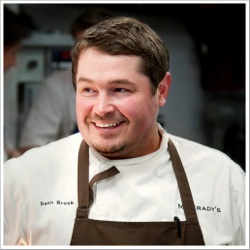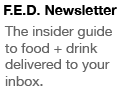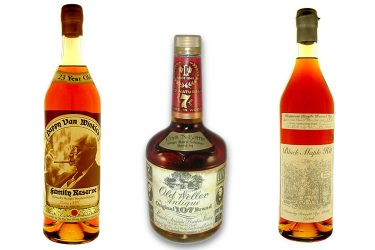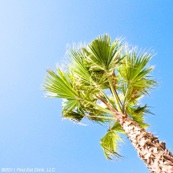Sean Brock, Chef, McCrady’s, Husk ,Restaurant, Recommendations, Food Purveyors, Recipes, Where to eat in Charleston, SC, South Carolina, Hemingway, Atlanta, GA, Georgia, Los Gatos, CA, California, San Francisco, New York, NY, Lower East Side, East Village, Midtown, Food Purveyors, Drinks, Liquor, Cookbooks, Whisky, Rye, What to Drink, What food provisions, staples to buy




Chef Sean Brock
Q & A WITH SEAN BROCK

Q. Tell us about your newest restaurant Husk.
A. Husk is like going to the farmers market, buying up all the beautiful stuff you can, without a budget, and coming home and saying what the hell are we going to cook? It’s the same exact thing we do at Husk. The idea is that we want to prove to the rest of the world that the South has the best food in the world. I’m talking about raw ingredients and tradition and history, and that is something I really believe.
Q. And you’ve given yourself strict rules and guidelines to work within.
A. We are only allowed to buy food grown or produced in the South. It’s pretty darn crazy. It handcuffs you and it says ‘look mister, you have to cook simple.’ Which works out perfectly because that is the idea of the restaurant. It’s about ingredients and this wood burning oven that we have.
Q. With everything coming from the South, what are your geographical boundaries?
A. That’s a great question and one we had to answer to order food properly. It’s about the Mason-Dixon line and down and that’s our South.
Q. And across?
A. Texas. We love Texas. If you think about it, it is the South. We found that all we really get from Texas is olive oil and all we get from Florida is citrus and this salt [Florida Keys Sea Salt], that is unbelievable.
Q. As you’ve been doing this, what ingredient has surprised you the most or maybe you under-appreciated?
A. Salt. Vinegar. Chocolate. Flour. All things that we take for granted.
We’re making our own fleur de sel. We have a fisherman that goes out to this area called The Charleston Shelf, and it’s just the most pristine waters and we’re dehydrating that sea water to make our own finishing salt. And we use a lot of salt from our friends on ‘Tabasco Island;’ there is a salt mine underneath Avery Island.
When you taste real salt, it’s like holy shit! I gotta learn how to season things again. The first couple of nights we were open, everything we cooked was so damn salty, because we were used to using what everybody else uses (like a kosher salt that chefs buy in boxes). All that salt has anti-caking agents in it and extenders to keep it from caking up. So, it’s diluted.
Q. You have such a specific idea for Husk, how do you change it for McCrady’s?
A. If you eat dinner at Husk on Wednesday and sit down and eat the tasting menu at McCrady’s on Thursday, you wouldn’t know it was the same chef. It’s really a lot of fun, because they are two completely different styles of cooking.
We want the food to not only be knock-down, drag out delicious, but intriguing and interesting. We won’t put a dish out of the kitchen unless its new, unique or interesting. If we’ve seen it before or it’s common, it won’t leave the kitchen. That’s how we push ourselves to create and be creative.
Q. Where does the inspiration come from?
A. When we create a dish, and same thing at Husk, I call it the PIE Theory: Products, Inspiration, Execution.
It starts with the products, we let them fall into our hands. We have enough of a relationship formed with fishermen, artisans, and farmers that when they harvest something beautiful, they call us. We find ourselves with a blank piece of paper and we walk around the kitchen and we write down all the ingredients. We sit down and okay, that’s the product part.
Then we choose the protein or the star of the dish; it could be turnips. Then we hold that ingredient and we taste it. We check the sugar level, really think about it and we look back to previous dishes and ideas. Maybe things we’ve read about and/or eaten or cooked and start being inspired. We let the product inspire us.
Then we talk about execution and you can dream up a lot of things, but can you do it when the dining room has 200 people?



January 18, 2011
Who
Executive Chef Husk and McCrady’s in Charleston, South Carolina.
Why
James Beard award-winning chef Brock has imposed his own strict rule that every item served must be grown in and have historical relevance to the South.



McCRADY’S & HUSK - CHARLESTON, SC

Charleston
American
76 Queen Street
Charleston, SC 29401
T: 843.577.2500 (make a reservation)
Website:
www.huskrestaurant.com
Hours:
Restaurant
Mon - Sat: 11:30am - 2:30pm
Sun: 10am - 2:30pm
Sun - Thu: 5:30pm - 10pm
Fri - Sat: 5:30pm - 11pm
Bar
Daily: 4pm - close
Charleston
Contemporary American
2 Unity Alley
Charleston, SC 29401
T: 843.577.0025 (make a reservation)
Website:
Hours:
Sun - Thu: 5pm - 9:30pm
Fri - Sat: 5pm -10:30pm



Photograph courtesy of Sean Brock

Recommended By
Recommendations
Sean Brock’s recommendations on where to eat and drink in Charleston, Hemingway, Atlanta, New York, Los Gatos, and San Francisco.








Share



Drink | Bourbon

Pappy Van Winkle | Old Weller | Black Maple
Pappy Van Winkle
All of the Pappy Van Winkles are outrageous. Julian Van Winkle is the grandson of Pappy Van Winkle, he took what was left of his grandpa’s Old Fitzgerald whisky after his distillery closed and he started aging it 10, 12 ,15, 20 and 23 years.
Old Weller
It’s basically Pappy Van Winkle. It’s that old wheated recipe. It’s just super super tasty and it’s half the price of Pappy Van Winkle.
Black Maple Hill Rye 23 Years
I’m a bourbon enthusiast, but I prefer rye over bourbon. Rye just has a different flavor. It’s a bit spicier and it finishes with a whole different complexity and when you age a rye 23 years, it’s just magical.
[See details.]
Recommendations

Details of Sean Brock’s recommendations on where to eat and drink in Charleston, Hemingway, Atlanta, New York, Los Gatos, and San Francisco.
Recipes

City Guides

- Charleston, SC: Online | Downloadable PDF

CHARLESTON, SC

Eat | Restaurants
Charleston | Glass Onion
I like it because I can go in there with a baseball cap on and sit there and not worry about anything and eat beautiful ingredients prepared by honest people. Just the simplest form of cooking.
Charleston | Martha Lou’s Kitchen
I’m a big fan of this place. It’s a soul food place. It’s a cinderblock building, tiny, only has about 5 or 6 booths in it, a home stove and one employee, Martha. You walk in, she greets you, asks you how your day is, how hungry you are, what you want to drink, and the sweet tea is so good, and you look back in the kitchen and it’s pots of lima beans simmering away, collard greens and she fries the chicken to order. You don’t see that anymore. It’s the closest I’ve ever felt to being in someone’s home at a restaurant. The food has so much pork and salt and it’s just so tasty.
Charleston | Bowen’s Island Restaurant
When you’ve got Wylie Dufresne in town or David Chang or George Mendes or Johnny Iuzzini, this is where you take them. When you want somebody to feel the Lowcountry, you go to Bowen’s Island and you eat shovels and shovels full of roasted oysters. It’s a little restaurant.
Hemingway, SC | Scott’s Bar-B-Que
Hands down my most favorite place to eat in the entire world and obviously the South. This shit will blow your mind. Oh my God! It’s food that makes you say that. I can’t believe how wonderful this is. I’m so jealous of what he does. He is a force to be reckoned with.
[See details.]
Drink | Bars
Cocktails | The Gin Joint
Joe Raya is the bartender/owner and I’ve never had better cocktails anywhere. They are doing just very creative, really neat stuff. They know what they’re doing and they’re really passionate about it. They’ve got great palates; they are chefs. They look at cocktails like dishes and you taste that and it’s just so good. And it’s across the street from McCrady’s.
[See details.]
Eat | Restaurants Around The Country
Los Gatos | Manresa
My first meal there changed me. Chef David Kinch is such a brilliant chef, he has his own garden, and basically it’s vegetables and seafood, there is very little meat. You just taste purity and honesty, He is really creative, but he’s mature enough not to let that get the best of him. There is some playfulness throughout the meal, just enough to not make it boring. It’s just ridiculously delicious.
[See details.]
San Francisco | Coi Restaurant
Daniel Patterson is constantly pushing, but still staying simple and clean. I really, really like his food.
[See details.]
Atlanta | Holeman & Finch Public House
They can serve anything they want there. The fact that they can serve testicles if they want to. The crazier the better, and the cheeseburger is outrageous.
[See details.]
New York | Momofuku - All Of Them
Momofuku is flat out delicious.
New York| Aldea - George Mendes
I love it -- it’s his heritage. You see this person cooking from their heart, in this cutest little modern restaurant in New York City and you just taste it.
New York | WD-50
I can’t leave New York City without eating there because Wylie’s food is so intriguing. How does he come up with this stuff? He is a genius.
[See details.]
Find | Indispensable Cookbooks
I don’t even sleep. I just sit up and read these things.
American Cooking: Southern Style
It’s from the old Time Life Cooking Series. This is Southern food. These are the stories and the pictures. These are the people who make the food and this is the person who grows the sorghum and uses the horse-drawn mill to extract juice and cooks it in a wood fire kettle. It’s all in that book - such a cool thing.
Carolina Rice Kitchen
It tells the real story. It shows where it all started and it shows you the work that goes into a kernel of rice and how the cuisine evolved, that it started from the seed.
The Physiology of Taste, Harder’s Book of Practical American Cookery
It’s my new find. The author is Jules Arthur Harder and it’s the coolest book you’ll ever get. I love the opening page. It’s a list of every single vegetable imaginable and it gives a little essay about that vegetable and a couple of recipes. It blows my mind.
The Southern Farmer & Market Gardener
It’s from the 1800’s and it’s very cool.
The Southern Gardener and Receipt Book
This was first published in 1845.
200 Years of Charleston Cooking
This cookbook is a collection of a lot of the early Charleston cooking.
[See details.]
RECOMMENDATIONS

Find | Southern Food Purveyors
Southern Ingredients
Here in Charleston from 1700 to 1860, it was the golden era of cooking, the golden rice era. We had rice plantations for 300 miles from Georgia to Florida in the South and most of them started in Charleston in 1681. Civil War happens and the labor force is gone. By 1927 the last rice is harvested in Charleston. It was forgotten about. So, what happens when the rice disappears?
Fast forward to the 1980’s and you start to see chefs, especially in Charleston, who are inspired by the history and years of inspiration and cooking and agriculture and people want to revive traditional dishes. Well guess what? They’re making Hoppin’ John with Uncle Ben’s rice, that taste like the box it came in. And they’re using black eyed peas that can double as deer feed, have no flavor and are so genetically engineered that they taste like nothing. They don’t look like anything. So here, we have a situation where we’re trying to show everybody our history and how beautiful the food was, but we didn’t have the ingredients.
Rice & Grains | Anson Mills
In the late 1990’s, David Shields and Glenn Roberts from Anson Mills started finding these seeds and dedicating their life to bringing these plants back. And now we can cook these foods with pride and get excited about rice.
Ham | Benton’s Smoky Mountain Country Hams
We have their ham in the bar and you just slice it as you want it. You eat that country ham and you drink it with bourbon, there is nothing else in the world that matters. It’s the smoke. Nobody uses as much smoke as he does. It is outrageous. If you put the tiniest amount of Benton’s bacon into anything, it’s like MSG, it just makes it. It’s just incredible.
Products | Bourbon Barrel Foods (Louisville, KY)
There is a guy named Matt Jamie and he is aging all these wonderful things in bourbon barrels. They smoke different spices and things, so you can get bourbon barrel smoked salt, smoked peppercorns, and smoked paprika. He’s making soy sauce from non-GMO soy beans grown in Kentucky, doing it the old-fashioned way. It will blow your mind.
Chocolate | Olive & Sinclair Chocolate Co. (Nashville, TN)
Obviously, we don’t grow cocoa beans here. When I lived in Nashville, there was this crazy kid, who would always stage with me, named Scott Witherow. Today, he has his own chocolate factory in Nashville. It’s called Olive & Sinclair. Any dish with his chocolate in it is so outrageous, because this chocolate is so incredible.
[See details.]





















